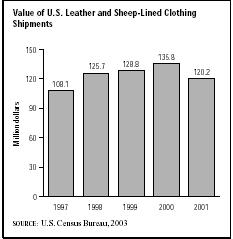SIC 2386
LEATHER AND SHEEP-LINED CLOTHING
This category consists of manufacturers of many types of leather and sheep-lined clothing, including coats, jackets, hats, pants, skirts, vests, and other garments. Companies that make leather gloves and mittens are included in SIC 3151: Leather Gloves and Mittens. Fur clothing is classified separately in SIC 2371: Fur Goods.
NAICS Code(s)
315292 (Fur and Leather Apparel Manufacturing)
Between 1990 and 2000, the number of establishments in the industry declined more than 20 percent. In 2001, the leather and sheep-lined clothing industry shipped about $120.2 million in products, down from $135.8 million in 2000. Overall, retail sales of leather apparel had almost quadrupled since 1985. These increases reflected the end of an upward trend in the price of leather. The cost of leather relative to other clothing materials has proved to be a reliable indicator of the leather apparel industry's performance from year to year. As is the case in the apparel industry in general, patterns of consumption can change rapidly as customer demand is influenced by fashion developments. Leather clothing, which is both high-fashion and high-cost in the world of apparel, is particularly susceptible to both of these kinds of fluctuations in demand. Therefore, when the U.S. economy deteriorated in the early 2000s, so did sales of leather apparel.

In the spring of 1997, the U.S. Air Force had contracted Avirex to create a replica of the 1931 A-2 leather flight jacket with special artwork on it to commemorate the military branch's fiftieth anniversary. More than 400 high-ranking Air Force officials—including the Commanderin-Chief, President Bill Clinton—wore these special jackets at ceremonies celebrating the anniversary in Las Vegas. Subsequently, Avirex offered the jackets for sale to the public for about $320 at the Cockpit stores in New York City, Beverly Hills, and via a toll-free number. Avirex began to sell its aviator wear online in 2002.
Although demand for leather apparel was expected to rise slightly as the American economy was expected to improve in 2004 and 2005, the market share lost to imports was expected to increase as well. In addition, American companies were moving more of their manufacturing abroad to reduce labor costs. These were the most severe challenges facing the industry in the early 2000s.
The top three industry leaders for this category were L.L. Bean Inc. of Freeport, Maine, with 3,800 employees and sales of almost $1.1 billion in 2003; DeLong Sportswear Inc. of Grinnell, Iowa, with sales of $25 million; and Avirex Ltd. of Long Island City, New York, with sales of $18 million. Other significant companies in the industry included Gem Dandy Inc. of Madison, North Carolina, and Berlin Glove Company Ltd. of Berlin, Wisconsin.
While current figures for employment in the leather and sheep-lined clothing segment are not yet available from the U.S. Census, employment in the broader fur and leather apparel industry totaled 2,770 in 2000. Total payroll costs were $63.4 million. Production workers, who numbered 2,318, earned an average wage of $11.19.
Further Reading
U.S. Census Bureau. "Statistics for Industry Groups and Industries: 2000." February 2002. Available from http://www.census.gov/prod/2002pubs/m00as-1.pdf .
——. "Value of Shipment for Product Classes: 2001 and Earlier Years." December 2002. Available from http://www.census.gov/prod/2003pubs/m01as-2.pdf .
Comment about this article, ask questions, or add new information about this topic: